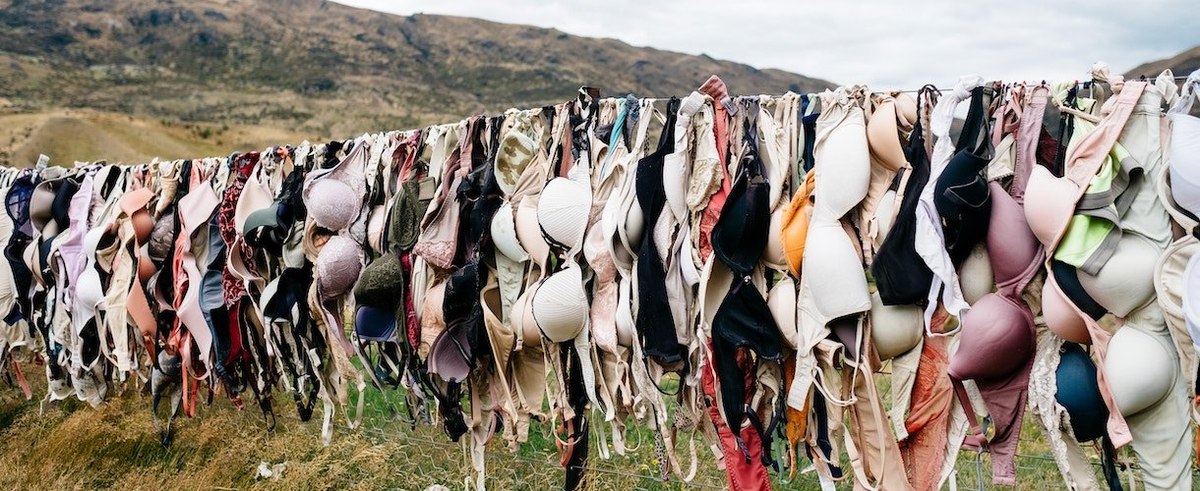Bras support most women on a daily basis, but do women support wearing bras? A recent YouGov poll explores American women's experiences with bras, and their opinions on them. Eight in 10 women say they wear one most days, though far fewer do so when relaxing alone at home. And a majority say they are more comfortable when they are braless than when they are wearing a bra. Age divides women's opinions on other bra-related questions, such as whether it's acceptable to go without one in public, what's fashionable, bras' health effects, and if they feel social pressure to wear one. Younger women are more likely to be resistant to bras and the social pressure surrounding them. They are also more likely than older women to say women should have the right to go topless in public.
How often and when women wear bras
Four in five American women say that during a typical week, they wear a bra most days, including 61% who wear one every day; just 5% never wear one. One in five women (21%) say they wear a bra less often than they did five years ago.
Most women say they always wear a bra when at a restaurant (79%), formal event (78%), or store (72%). Among women who say the question is applicable to them, 86% say they always wear a bra at work. There is more division on how often women wear bras while relaxing at home: 60% say they sometimes or never do and 37% say they always or usually do. Just 12% say they always or usually wear a bra while sleeping. Younger women are less likely than older women to say they always wear a bra at a restaurant, store, or formal event.
At least half of women have at some point in their lives worn each of the following kinds of bras: a wireless bra (73%), a sports bra (71%), an underwire bra (70%), and a strapless bra (50%). Nearly half (47%) have worn a push-up bra. Far fewer, however, say they regularly wear these bras: 44% say they regularly wear a wireless bra, 36% a sports bra, and 29% an underwire bra. Women under 45 are more likely than older women to say they regularly wear a sports bra, push-up bra, and bralette.
Comfort, fashion, health, and social pressure
Women who have worn a bra generally consider wearing one to be more uncomfortable than going braless. More women who've worn a bra say that wearing one is very or somewhat uncomfortable (53%) than very or somewhat comfortable (45%). Not wearing a bra is viewed as uncomfortable by just 33%, while 63% say it is comfortable.
While more Americans overall say they personally consider it always or usually acceptable for women to not wear a bra in public than say it is unacceptable (50% vs. 38%), women are divided on the issue: 42% say it is acceptable and 45% say it is unacceptable. Among women, age further divides opinion: 51% of women under 45 say it is acceptable, compared to just 36% of older women. Age is also a factor in how men feel about women going braless, albeit in the opposite direction: 51% of men under 45 say it is acceptable compared to 65% of older men.
About one in three women (37%) say they feel social pressure to wear a bra. Younger women are especially likely to say this: 45% of women under 30 say they feel pressure to wear a bra, compared to 28% of women 65 and older.
More Americans think it is fashionable to wear a bra (60%) than to go braless (13%). Women are 10 percentage points more likely than men (65% vs. 55%) to say it's more fashionable to wear a bra than to not. But among women, there is a sizable age divide: 53% of women under 45 say bras are most fashionable, compared to 74% of older women.
What effects do American women think bras have on their health? While a plurality of women (41%) say wearing a bra has a neutral effect on a woman's health, more say doing so has a very or somewhat positive effect (27%) than a negative effect (12%). Older women are far more likely to believe there are positive effects than negative effects, while younger women are more divided.
The right to go topless in public
The Free the Nipple movement — which advocates for women having the right to go topless in public, as men do — is known about by 38% of U.S. adults. Women under 30 (66%) are among the groups that are most likely to have heard of it. Fewer say they strongly or somewhat support (34%) the movement than oppose it (53%).
Even though the Free the Nipple movement is largely led by women and claims to advocate for their rights, men (46%) are nearly twice as likely as women (25%) to support the movement's goal of allowing women to go topless in public. While age does not divide the opinions of men, it is a major predictor of women's opinion: 37% of women under 45 support allowing women to go topless in public, compared to just 15% of older women.
Going commando
A separate recent YouGov survey of over 30,000 U.S. adults asked about opinions on another common type of undergarment: underwear. Americans are split on whether it is acceptable for an adult to go commando — that is, not wear underwear — in public: 40% say it is always or usually acceptable and 40% say it is always or usually unacceptable. Men are somewhat more likely than women to view going commando in public as acceptable (45% vs. 35%).
Most Americans say they go commando on at least some occasions, though few say they do so frequently during the day. Significantly more say they always or often go commando while sleeping (30%) than say they do so when awake (17%). American adults under the age of 45 — including both men and women — are more likely than those who are older to say they sometimes go commando, either during the day or at night.
Related:
- American women describe their experiences with menstrual periods
- American women describe their experiences with menopause
— Carl Bialik contributed to this article
Methodology for survey on bras: The poll was conducted among 2,000 U.S. adult citizens on two separate surveys from September 8 - 12, 2023 and September 13 - 20, 2023, with each survey taken by 1,000 U.S. adult citizens. Respondents were selected from YouGov’s opt-in panel using sample matching. A random sample (stratified by gender, age, race, education, geographic region, and voter registration) was selected from the 2019 American Community Survey. The sample was weighted according to gender, age, race, education, 2020 election turnout and presidential vote, baseline party identification, and current voter registration status. Demographic weighting targets come from the 2019 American Community Survey. Baseline party identification is the respondent’s most recent answer given prior to November 1, 2022, and is weighted to the estimated distribution at that time (33% Democratic, 31% Republican). The margin of error for the overall sample is approximately 3%.
See the results for the YouGov survey on bras
Note: Responses to questions on personal experiences with bras are limited to women. This decision was aimed at ensuring data accuracy. However, this approach may not capture the experiences of men, non-binary people, or transgender people who wear bras.
Methodology for survey on underwear: This Daily Questions survey was conducted online on September 15 - 18, 2023 among 34,025 U.S. adults. The sample was weighted according to gender, age, race, education, U.S. census region, and political party.
See the results for the YouGov survey on underwear
- How often do you consider it to be acceptable or unacceptable for an adult in public to go commando — that is, not wear underwear?
- When you’re awake, how often do you go commando?
- While sleeping, how often do you go commando?
Image: Unsplash (Pablo Heimplatz)












